Activated carbon is a microcrystalline material made from the thermal decomposition of wood, coconut shells, coal, and others. Activated carbon is consider good adsorbent and mainly used in the adsorption process of many industries. Observing from the source of the material used, there are a several types of activated carbon.
Coal based activated carbon
Coal-based activated carbon is available in four basic types of materials – bituminous, sub-bituminous, anthracite & lignite, consisting of micro, meso and macro pore structures. This unique pore distribution makes coal based activated carbon ideal for removing small to large molecular structures.
Wood based activated carbon
Wood-based activated carbon is produced from selected types of wood. Most of the wood-based carbon is ideal for discoloration of liquids and water. Wood based activated carbon is mainly used in surface water and wastewater filters to remove organic impurities and effectively remove larger molecular structures.
Coconut shell based activated carbon
Coconut shell activated carbon has a high hardness and is more abrasion resistant than others. It is also eco-friendly product as the raw materials sources are from the waste coconut shells. Coconut shell carbon is also more efficient to absorb impurities with micro-molecular structures.









